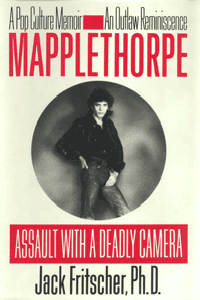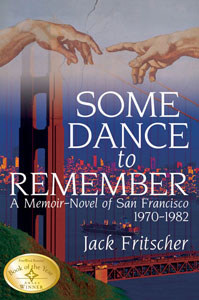Book Citations
Northern Express Weekly
September 16, 1998
by Nancy Sundstrom
The 70’s are back...with a vengeanceGay author recalls a rebel with a camera and San Francisco days
Movies like “Boogie Nights” and “54,” the new “That 70’s Show” on TV and the resurgence of disco music and fashions are being championed by people who were barely out of their Huggies when the era was at is absurd peak. That is nothing short of perplexing to those of us who were grateful to move onto the even more superficial 1980’s, but what the heck–a few extra re-runs of “The Brady Bunch” never hurt anybody.
If you’re interested in two serious, insightful and memorable looks at the transition from the 70’s to the 80’s, then be sure to pick up that pop culture memoir “Mapplethorpe: Assault with a Deadly Camera” and its worthy companion piece, the fictional epic “Some Dance to Remember,” both by the gifted writer Jack Fritscher.
A Ph.D. who earned his doctorate in American Literature at Loyola College in Chicago and f former professor at Western Michigan University at Kalamazoo, the brilliant Fritscher has authored six fiction and four non-fiction books; written countless essays, articles, plays and film scripts; photographed the coffee-table book “Jack Fritscher’s American Men” and cover for over 20 magazines and books; founded legendary Drummer magazine in San Francisco; and like fellow author Anne Rice, has long written for both the mainstream and the underground.
The Undiscovered Mapplethorpe

It was while Fritscher was the editor at Drummer in 1977 that a then-undiscovered Robert Mapplethorpe asked him to look at his portfolio of photographs. Fritscher was immediately intrigued by Mapplethorpe’s unique camera eye and assigned him for a magazine cover. They became friends, colleagues and lovers, and after their relationship ended, Mapplethorpe went on to international stardom, a storm of controversy and death at age 42 from AIDS. Fritscher went on to become a prolific writer whose many subjects included his reminiscence of his years with Mapplethorpe.
Largely based from Fritscher’s journals and collection of letters, notes, photographs and reviews he kept on “this most determined of artists,” “Mapplethorpe” is a memoir, not a biography. At the onset, Fritscher gives the advisory that “This pop culture memoir contains, sex, lies, greed, perversion, murder, deceit, infidelity, drugs, sex, immortality, scatology, ambition, equivocation, character assassination, slander, blasphemy, aspersion, betrayal, distortion, racism, ungodliness, sodomy–and that’s just the critics of Mapplethorpe.” It’s a clear caveat for what’s to follow.
What Fritscher captures so well is the essence of the tumultuous ’70’s and the spirit of an artist who wanted “to be a story told around the world,” and paid the price with his life. Fritscher’s remembrance is so personal than he writes “takes,” not chapters, and his intimate relationship with his subject provides a unique point of view that couldn’t be expressed by another biographer.
Art is always in the eye of the beholder, and the validity and purpose of Mapplethorpe’s will long be debated. Fritscher lets us know that without the dark side of the soul, there can be no saint, and that Mapplethorpe was living proof that moments may be perfect, but people are not.
Life in the Castro District

“Some Dance to Remember” contains a dedication to Robert Mapplethorpe and “for the 14,000 veterans of the Golden Age of Liberation who each gave me a piece of his heart.” Spanning 1970-1982, the book, which borrows its title from an Eagles song from the album “Hotel California,” is a fable, a “docudramedy” (as the author calls it) and as a document of gay life in the Castro district of San Francisco, has no peer.
As with most epics, a colorful ensemble cast of characters provide and propel the action; a gonzo writer, a hunky bodybuilder, an erotic video mogul, a cabaret chanteuse, a Vietnam vet and a Hollywood television producer, among many others. One of Fritscher’s many gifts as a writer is that he clearly loves all his diverse characters, and fleshes them out with their own voices, foibles and dilemmas.
Meld in some significant social issues, like the burgeoning gay liberation movement, civil rights, AIDS and crime, then throw in a murder, and a healthy dose of drugs, sex, and rock and roll, and you have the framework for a book that was hailed as the Castro’s version of “Gone With the Wind.”
Though the author clearly wrote from the perspective of someone who experienced the time, place and persons like those in the book, he states up-front that it’s not an autobiography, but an imagined journey through a personal heart. Part of the book’s beauty is the recognition the reader has of themselves in many of these characters at the intersection of 18th and Castro.
“In the pursuit of excellent, these is no fault in high expectation,” writes Fritscher at the book’s poignant end. “There is only virtue. Then, finally, comes the realization that the quest is of itself the only importance. The quest has no end. The questions have no answers. The questions themselves are the answers, and the quest its own end.”
In “Some Dance to Remember,” Fritscher’s quest was to chronicle an era, and through a fictional platform, pose questions that can only be answered in the heart. “Some Dance to Remember” is a book to remember, and its humanity, humor and intelligence is a tribute to many who won’t be forgotten as well.
copyright Nancy Sundstrom